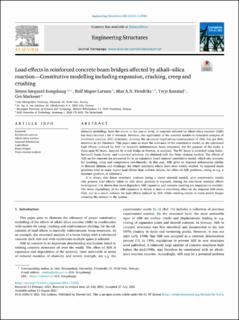Load effects in reinforced concrete beam bridges affected by alkali–silica reaction—Constitutive modelling including expansion, cracking, creep and crushing
| dc.contributor.author | Kongshaug, Simen Sørgaard | |
| dc.contributor.author | Larssen, Rolf Magne | |
| dc.contributor.author | Hendriks, Max | |
| dc.contributor.author | Markeset, Gro | |
| dc.contributor.author | Kanstad, Terje | |
| dc.date.accessioned | 2021-09-30T13:27:01Z | |
| dc.date.available | 2021-09-30T13:27:01Z | |
| dc.date.created | 2021-08-16T16:20:09Z | |
| dc.date.issued | 2021-08-13 | |
| dc.identifier.issn | 0141-0296 | |
| dc.identifier.uri | https://hdl.handle.net/11250/2786701 | |
| dc.description.abstract | Material modelling, from the micro to the macro level, of concrete affected by alkali–silica reaction (ASR) has been devoted a lot of research. However, the application of the material models in structural analyses of reinforced concrete (RC) structures, showing the structural implications/consequences of ASR, has got little attention in the literature. This paper aims to show the relevance of the constitutive model on the calculated load effects—induced by ASR—in statically indeterminate beam structures. For the purpose of the study, a three-span RC beam, inspired by a real bridge in Norway, is analysed. The RC beam is modelled using Euler–Bernoulli beam theory, and numerical solutions are obtained with the finite element method. The effects of ASR on the concrete are accounted for in an expansion based (macro) constitutive model, which also accounts for cracking, creep and compressive non-linearity. In this way, ASR gives an imposed deformation similar to thermal dilation and shrinkage, for which structural effects have been widely studied. As imposed strain gradients tend to cause higher load effects than uniform strains, the effect of ASR gradients, owing to e.g. a moisture gradient, is addressed. It is shown that linear structural analyses (using a linear material model), give conservative results (the greatest load effects) when an ASR strain gradient is imposed. Among the non-linear material effects investigated, it is shown that stress dependent ASR expansion and concrete cracking are important to consider. The stress dependency of the ASR expansion is shown to have a smoothing effect on the imposed ASR strain field, and as a result, reduces the load effects induced by ASR, while cracking results in crack/plastic hinges releasing the stresses in the system. | en_US |
| dc.language.iso | eng | en_US |
| dc.publisher | Elsevier | en_US |
| dc.relation.ispartofseries | Engineering structures;Volume 245, 15 October 2021, 112945 | |
| dc.rights | Navngivelse 4.0 Internasjonal | * |
| dc.rights.uri | http://creativecommons.org/licenses/by/4.0/deed.no | * |
| dc.subject | Reinforced concrete | en_US |
| dc.subject | Alkali-silica reactions | en_US |
| dc.subject | Imposed deformations | en_US |
| dc.subject | Load effects | en_US |
| dc.subject | Beam bridges | en_US |
| dc.subject | Finite element analyses | en_US |
| dc.title | Load effects in reinforced concrete beam bridges affected by alkali–silica reaction—Constitutive modelling including expansion, cracking, creep and crushing | en_US |
| dc.type | Peer reviewed | en_US |
| dc.type | Journal article | en_US |
| dc.description.version | publishedVersion | en_US |
| dc.rights.holder | © 2021 The Authors. | en_US |
| dc.source.articlenumber | 112945 | en_US |
| cristin.ispublished | true | |
| cristin.fulltext | original | |
| cristin.qualitycode | 2 | |
| dc.identifier.doi | https://doi.org/10.1016/j.engstruct.2021.112945 | |
| dc.identifier.cristin | 1926430 | |
| dc.source.journal | Engineering structures | en_US |
| dc.source.volume | 245 | en_US |
| dc.source.pagenumber | 1-17 | en_US |
Files in this item
This item appears in the following Collection(s)
-
Publikasjoner fra Cristin [3256]
-
TKD - Institutt for bygg- og energiteknikk [416]
TKD - Department of Built Environment

